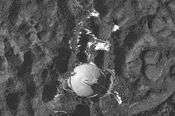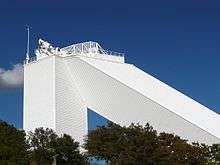List of astronomical observatories
This is a list of astronomical observatories ordered by name, along with initial dates of operation (where an accurate date is available) and location. The list also includes a final year of operation for many observatories that are no longer in operation. While other sciences, such as volcanology and meteorology, also use facilities called observatories for research and observations, this list is limited to observatories that are used to observe celestial objects.
Astronomical observatories are mainly divided into four categories: space based, airborne, ground based and underground based.
Many modern telescopes and observatories are located in space to observe astronomical objects in wavelengths of the electromagnetic spectrum that cannot penetrate the Earth's atmosphere (such as ultraviolet radiation, X-rays, and gamma rays) and are thus impossible to observe using ground-based telescopes.[1] Being above the atmosphere, these space observatories can also avoid the effects of atmospheric turbulence that plague ground based telescopes, although new generations of adaptive optics telescopes have since then dramatically improved the situation on the ground. The space high vacuum environment also frees the detectors from the ancestral diurnal cycle due to the atmospheric blue light background of the sky, thereby increasing significantly the observation time.
An intermediate variant is the airborne observatory, specialised in the infrared wavelengths of the EM spectrum, that conduct observations above the part of the atmosphere containing water vapor that absorbs them, in the stratosphere.
Historically, astronomical observatories consisted generally in a building or group of buildings where observations of astronomical objects such as sunspots, planets, asteroids, comets, stars, nebulae, and galaxies in the visible wavelengths of the electromagnetic spectrum were conducted. At first, for millennia, astronomical observations have been made with naked eyes. Then with the discovery of optics, with the help of different types of refractor telescopes and later with reflector telescopes. Their use allowed to dramatically increase both the collecting power and limit of resolution, thus the brightness, level of detail and apparent angular size of distant celestial objects allowing them to be better studied and understood. Following the development of modern physics, new ground based facilities have been constructed to conduct research in the radio and microwave wavelengths of the electromagnetic spectrum, with radio telescopes and dedicated microwave telescopes.
Modern astrophysics has extended the field of study of celestial bodies to non electromagnetic vectors, such as neutrinos, neutrons and cosmic-rays or gravitational waves. Thus new types of observatories have been developed. Interferometers are at the core of gravitational wave detectors. In order to limit the natural or artificial background noise, most particle detector based observatories are built deep underground.
A

B
C
D
| Name | Established | Location |
| Daniel S. Schanck Observatory (defunct) | 1865 | Rutgers University, New Brunswick, New Jersey, USA |
| Daniel Scholl Observatory (defunct) | 1886–1966 | Lancaster, Pennsylvania, USA |
| Dark Sky Observatory | 1981 | Phillips Gap, Wilkes County, North Carolina, USA |
| Darling's Observatory (defunct) | 1917 | Duluth, Minnesota, USA |
| Dearborn Observatory | 1889 | Evanston, Illinois, USA |
| Detroit Observatory | 1854 | Ann Arbor, Michigan, USA |
| David Dunlap Observatory | 1935 | Richmond Hill, Ontario, Canada |
| Dome C | Antarctica | |
| Dominion Observatory | 1905 | Ottawa, Ontario, Canada |
| Dominion Astrophysical Observatory | 1947 | Saanich, British Columbia, Canada |
| Dominion Radio Astrophysical Observatory | 1960 | Okanagan Falls, British Columbia, Canada |
| Dunsink Observatory | 1785 | Dublin, Ireland |
| Dyer Observatory | 1953 | Brentwood, Tennessee, USA |
E
| Name | Established | Location |
| Effelsberg 100-m Radio Telescope | 1972 | Bonn, Germany |
| Ege University Observatory | 1965 | Kemalpaşa, Izmir, Turkey |
| Einstein Observatory (defunct) | 1978 | Low Earth orbit |
| Elginfield Observatory | 1969 | Middlesex Centre, Ontario, Canada |
| Ellis Observatory | 2004 | Sterling Hill Mining Museum, Ogdensburg, New Jersey, USA |
| Embry-Riddle Observatory | 2005 | Daytona Beach, Florida, USA |
| Eskdalemuir Observatory | 1908 | Dumfries and Galloway, Scotland |
| European Gravitational Observatory | 2003 | Cascina , Italy |
| European Southern Observatory | 1962
|
Atacama Desert, Chile |
F
G
H
I

| Name | Established | Location |
| IceCube Neutrino Observatory | 2010 | Amundsen–Scott South Pole Station |
| Indian Astronomical Observatory | 2001 | Hanle, Jammu and Kashmir, India |
| Instituto de Astrofísica de Canarias | 1975 | Canary Islands, Spain |
| INTEGRAL | 2002 | Highly eccentric Earth orbit |
| Infrared Astronomical Satellite (IRAS) (defunct) | January–November 1983 | Earth orbit |
| Infrared Space Observatory (ISO) (defunct) | 1995–1998 | Earth orbit |
| Innsbruck Observatory | Innsbruck, Austria | |
| IRAM 30m telescope | 1984 | Pico Veleta, Spain |
| IRAM Plateau de Bure Interferometer | 1988 | Gap, Hautes-Alpes, France |
| Iranian National Observatory | 2017 | Mount Gargash, Iran |
| Isaac Newton Group of Telescopes | 1979 | La Palma, Spain |
| Iso-Heikkilä Observatory (defunct) | 1935 (only amateur use since 1972) | Turku, Finland |
| Istanbul observatory of Taqi al-Din | 1577 | Istanbul, Turkey |
| Istanbul University Observatory | 1936 | Istanbul, Turkey |
J
| Name | Established | Location |
| Jack C. Davis Observatory | 2002 | Carson City, Nevada, USA |
| Astronomical Observatory of the Jagiellonian University | 1792 | Cracow, Poland |
| James Clerk Maxwell Telescope | 1987 | Mauna Kea, Hawaii, USA |
| James Webb Space Telescope | 2018 (planned) | Earth–Sun L2 Lagrangian point |
| James Wylie Shepherd Observatory | 2009 | Montevallo, Alabama, USA |
| Jakarta Observatory | 1968 | Jakarta, Indonesia |
| Jantar Mantar | 1727 | Jaipur, Rajasthan, India |
| Jena Observatory | 1962 | Jena, Germany |
| Jewett Observatory | 1953 | Pullman, Washington, USA |
| Jodrell Bank Observatory | 1945 | Cheshire, England |
| Jones Observatory | 1936 | Chattanooga, Tennessee, USA |
| Judson B. Coit Observatory | Boston, Massachusetts, USA |
K
L

M

N
O
P
Q
| Name | Established | Location |
| Quito Astronomical Observatory | 1873 | La Alameda Park, Quito, Ecuador |
R
S
T
U
V

| Name | Established | Location |
| Valongo Observatory | 1881 | Rio de Janeiro, Brazil |
| Vainu Bappu Observatory | 1968 | Kavalur, Tamil Nadu, India |
| Astronomical observatory of Aosta Valley | 2003 | Nus (Aosta Valley, Italy |
| Van Vleck Observatory | 1914 | Middletown, Connecticut, USA |
| Vanderbilt University Observatory | Nashville, Tennessee, USA | |
| Vartiovuori Observatory (defunct) | 1819–1834 | Turku, Finland |
| Vassar College Observatory (defunct) | 1865 | Poughkeepsie, New York, USA |
| Vatican Observatory | 1891
|
Headquarters: Castel Gandolfo, Italy
|
| Veen Observatory | 1970 | Lowell, Michigan, USA |
| Vega–Bray Observatory | 1990 | Benson, Arizona, USA |
| Ventspils Starptautiskais Radioastronomijas Centrs | Irbene, Latvia | |
| Very Large Array | 1980 | Socorro, New Mexico, USA |
| Very Long Baseline Array | 1993 | Various locations |
| Vienna Observatory | 1753 | Vienna, Austria |
| Vilnius University Observatory | 1753 | Vilnius University, Lithuania |
| Višnjan Observatory | 1978 | Višnjan, Croatia |
| Vsetín Observatory | 1950 | Vsetín, Czech Republic |
W
X
| Name | Established | Location |
| Xiangfen Astronomical Observatory | 2100 B.C. | Xiangfen County, Linfen City, Shanxi Province, China |
| Xinglong Station (NAOC) | Yanshan County, Hebei, China | |
| Xinjiang Astronomical Observatory | 1968 | Urumqi, Xinjiang, China |
| XMM-Newton | 1999 | Highly eccentric Earth orbit |
| Xujiahui Astronomical Observatory | 1872 | Shanghai, China |
Y

| Name | Established | Location |
| Arctic Space Weather Center | Yakutsk, Russia | |
| Yale Student Observatory | New Haven, Connecticut, USA | |
| Yangbajing International Cosmic-Ray Observatory | Yangbajing Valley, Tibet, China | |
| Yantra Mandir | 1724 | New Delhi, Delhi, India |
| Yerevan Cosmic-Ray Station | Yerevan, Armenia | |
| Yerkes Observatory | 1897 | Williams Bay, Wisconsin, USA |
| York University Observatory | Toronto, Ontario, Canada | |
| Yuba City Astronomical Observatory | 2010 | Yuba City, California, USA |
| Yunnan Astronomical Observatory | 1957 | Kunming, Yunnan, China |
Z
| Name | Established | Location |
| Zimmerwald Observatory | 1956 | Zimmerwald, Switzerland |
See also
- List of highest astronomical observatories
- Subsections of Category:Astronomical observatories by country
- History of telescopes
- List of astronomical instrument makers
- List of observatory codes
- List of largest optical reflecting telescopes
- List of largest optical refracting telescopes
- List of radio telescopes
- List of telescope types
- Space observatory
- Timeline of telescopes, observatories, and observing technology
- List of planetariums
References
- ↑ Chaisson, Eric; McMillan, Steve (2002). Astronomy Today, Fourth Edition. Prentice Hall.
- ↑ http://www.archives.gov/research/guide-fed-records/groups/078.html
External links
- Ecuador National Observatory
- History of Astronomy: Observatories and other places
- American observatories by state/Link expired
- Observatories with Clear Sky Clocks
- Map of observatory locations
.jpg)



















